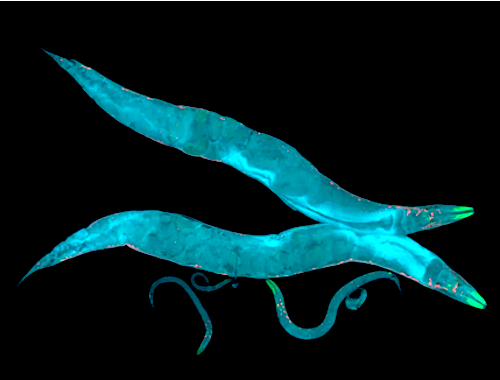|
|
Developmental Biology - Sex Determination
Blurring the Line Between the Sexes
Biological sex is typically understood as binary: male and female. But, there are many animals that modify their behavior to suit circumstances — even changing sex...
A new study appearing in the journal Current Biology, identifies a genetic switch in brain cells that can toggle between sexes when needed. Questioning the whole idea of sex as fixed from birth.
Research led by Douglas Portman PhD, associate professor, University of Rochester and conducted in C. elegans (a microscopic roundworm) - tells a unique story, but perhaps more common than thought.
Many discoveries made using C. elegans apply throughout the animal kingdom — leading to a broader understanding of human biology.
It is the only animal whose nervous system has been completely mapped, providing a wiring diagram - or connectome - helping researchers understand how brain circuits make decisions, integrate information and control behavior.
C. elegans Has 2 Sexes: Males and Hermaphrodites
As hermaphrodites are able to self-fertilize they can also mate with males and so are considered modified females. A single gene, TRA-1, determines the sex of C. elegans. When there is only one X chromosome, TRA-1 is inactivated. Therefore:
• a developing worm with two X chromosomes, is considered female
• a developing worm with one X chromosome, is considered male.
However, this new study reveals the TRA-1 gene isn't completely silent in males - as was thought. Instead, It becomes active when circumstances compel males to act more like females.
Typically, C. elegans males prefer searching for mates more than for food, partly as they can't smell food as well as females.
But, if a male goes too long without eating, it can increase its ability to detect food by acting more like a female.
The new research reveals that TRA-1 is needed for this switch. Without TRA-1, hungry males cannot enhance their sense of smell and will remain in mate-searching mode. TRA-1 does the same job in juvenile males - activating food detection in males too developmentally young to search for mates.
"These findings indicate that at the molecular level, sex isn't binary or static, but dynamic and flexible. The new results suggest aspects of the male nervous system might transiently take on a female 'state,' allowing male behavior to be flexible in response to internal and external conditions."
Douglas S. Portman PhD, Department of Biology, University of Rochester; Department of Biomedical Genetics, University of Rochester; and the Ernest J. Del Monte Institute for Neuroscience, University of Rochester, Rochester, New York, USA
Abstract/Highlights
• The master hermaphrodite sexual regulator tra-1 is expressed in male neurons
• tra-1 acts in juvenile males to suppress an adult-specific sexual dimorphism
• In adult males, tra-1 is necessary for the suppression of dimorphism by starvation
• Genetic control of sexual state in the nervous system is neither binary nor static
Summary
Biological sex in animals is often considered a fixed, individual-level characteristic. However, not all sex-specific features are static: for example, C. elegans males (XO) can sometimes exhibit hermaphrodite (XX)-like feeding behavior [1, 2]. (C. elegans hermaphrodites are somatic females that transiently produce self-sperm.) Essentially all somatic sex differences in C. elegans are governed by the master regulator tra-1, whose activity is controlled by chromosomal sex and is necessary and sufficient to specify the hermaphrodite state [3]. One aspect of this state is high expression of the chemoreceptor odr-10. In hermaphrodites, high odr-10 expression promotes feeding, but in males, low odr-10 expression facilitates exploration [4]. However, males suppress this sex difference in two contexts: juvenile males exhibit high odr-10 expression and food deprivation activates odr-10 in adult males [4, 5, 6]. Remarkably, we find that both of these phenomena require tra-1. In juvenile (L3) males, tra-1 is expressed in numerous neurons; this expression diminishes as individuals mature into adulthood, a process that requires conserved regulators of sexual maturation. tra-1 remains expressed in a small number of neurons in adult males, where it likely has a permissive role in odr-10 activation. Thus, the neuronal functions of tra-1 are not limited to hermaphrodites; rather, tra-1 also acts in the male nervous system to transiently suppress a sexual dimorphism, developmentally and in response to nutritional stress. Our results show that the molecular and functional representation of sexual state in C. elegans is neither static nor homogeneous, challenging traditional notions about the nature of biological sex.
.
Authors
Hannah N. Lawson, Leigh R. Wexler, Hayley K. Wnuk, Douglas S. Portman.
Acknowledgements
The authors are grateful to Emily Bayer and Oliver Hobert for generously sharing unpublished findings and to Matthew Berkseth and David Zarkower for pDZ118 and making their GFP::TRA-1 reporter strain available. We appreciate the feedback of the anonymous reviewers, who helped shape the interpretation of our findings. We thank current and former members of the Portman lab, the University of Rochester invertebrate genetics group, and the Western New York C. elegans community for discussion and feedback. Some strains used in this work were provided by the Caenorhabditis Genetics Center, which is funded by NIH Office of Research Infrastructure Programs ( P40 OD010440 ). These studies were funded by NIH R01 GM108885 and NIH R01 GM130136 to D.S.P.
.
Return to top of page.
|
|
Aug 19 2020 Fetal Timeline Maternal Timeline News
 New findings indicate that at the molecular level, sex isn't binary or static, but dynamic and flexible. CREDIT Shutterstock.com.
|
|



